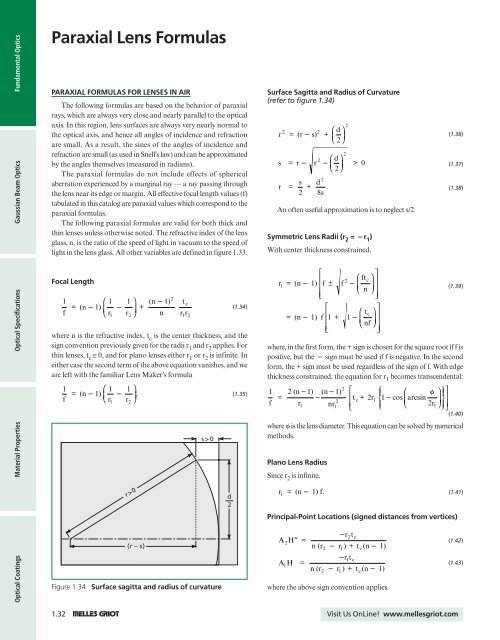Optical Coatings
Optical Coatings
Optical Coatings
Create successful ePaper yourself
Turn your PDF publications into a flip-book with our unique Google optimized e-Paper software.
Fundamental Optics<br />
Material Properties <strong>Optical</strong> Specifications Gaussian Beam Optics<br />
Paraxial Lens Formulas<br />
PARAXIAL FORMULAS FOR LENSES IN AIR<br />
The following formulas are based on the behavior of paraxial<br />
rays, which are always very close and nearly parallel to the optical<br />
axis. In this region, lens surfaces are always very nearly normal to<br />
the optical axis, and hence all angles of incidence and refraction<br />
are small. As a result, the sines of the angles of incidence and<br />
refraction are small (as used in Snell’s law) and can be approximated<br />
by the angles themselves (measured in radians).<br />
The paraxial formulas do not include effects of spherical<br />
aberration experienced by a marginal ray — a ray passing through<br />
the lens near its edge or margin. All effective focal length values (f)<br />
tabulated in this catalog are paraxial values which correspond to the<br />
paraxial formulas.<br />
The following paraxial formulas are valid for both thick and<br />
thin lenses unless otherwise noted. The refractive index of the lens<br />
glass, n, is the ratio of the speed of light in vacuum to the speed of<br />
light in the lens glass. All other variables are defined in figure 1.33.<br />
Focal Length<br />
1<br />
⎛ 1 1 ⎞ (n 41)<br />
= (n 41)<br />
4 +<br />
f<br />
⎜<br />
⎝ r r<br />
⎟<br />
⎠ n<br />
t c<br />
rr<br />
where n is the refractive index, t c is the center thickness, and the<br />
sign convention previously given for the radii r 1 and r 2 applies. For<br />
thin lenses, t c ≅ 0, and for plano lenses either r 1 or r 2 is infinite. In<br />
either case the second term of the above equation vanishes, and we<br />
are left with the familiar Lens Maker’s formula<br />
1<br />
f<br />
⎛<br />
= (n 41)<br />
⎜ 4<br />
⎝<br />
2<br />
1 1 ⎞<br />
⎟<br />
r1 r2⎠<br />
(1.35)<br />
(1.34)<br />
1 2<br />
1 2<br />
s>0<br />
Surface Sagitta and Radius of Curvature<br />
(refer to figure 1.34)<br />
2 2 ⎛ d ⎞<br />
r = (r 4s) + ⎜ ⎟<br />
⎝ 2⎠<br />
2 ⎛ d ⎞<br />
s = r 4 r 4⎜<br />
⎟<br />
⎝ 2⎠<br />
r<br />
1<br />
=<br />
f<br />
2<br />
= s 2 + d .<br />
8s<br />
2<br />
2<br />
> 0<br />
An often useful approximation is to neglect s/2.<br />
Symmetric Lens Radii (r 2 = 5r 1 )<br />
With center thickness constrained,<br />
⎡<br />
⎤<br />
ft<br />
2 c<br />
r 1 = (n 4 1)<br />
⎢ ⎛ ⎞<br />
f ± f 4<br />
⎥<br />
⎢ ⎜<br />
n<br />
⎟<br />
⎝ ⎠<br />
⎥<br />
⎣⎢<br />
⎦⎥<br />
⎡<br />
⎤<br />
tc<br />
= (n 4 1) f<br />
⎢ ⎛ ⎞<br />
1 + 14<br />
⎥<br />
⎢ ⎜<br />
⎝ nf<br />
⎟<br />
⎠<br />
⎥<br />
⎣⎢<br />
⎦⎥<br />
2 (n41)<br />
(n41)<br />
4<br />
r nr<br />
1<br />
2<br />
⎡ ⎧⎪<br />
⎛ f ⎞ ⎫⎪<br />
⎤<br />
⎢t + 2r ⎨14<br />
cos ⎜arcsin ⎝ 2r<br />
⎟ ⎬⎥<br />
⎩⎪<br />
1<br />
⎣<br />
⎢<br />
⎠ ⎭⎪ ⎦<br />
⎥<br />
(1.40)<br />
2 c 1<br />
1<br />
(1.36)<br />
(1.37)<br />
(1.38)<br />
(1.39)<br />
where, in the first form, the + sign is chosen for the square root if f is<br />
positive, but the 4 sign must be used if f is negative. In the second<br />
form, the + sign must be used regardless of the sign of f. With edge<br />
thickness constrained, the equation for r 1 becomes transcendental:<br />
where Ω is the lens diameter. This equation can be solved by numerical<br />
methods.<br />
Plano Lens Radius<br />
Since r 2 is infinite,<br />
r>0<br />
d<br />
2<br />
r 1 = (n 4 1) f.<br />
Principal-Point Locations (signed distances from vertices)<br />
(1.41)<br />
<strong>Optical</strong> <strong>Coatings</strong><br />
(r4s)<br />
Figure 1.34 Surface sagitta and radius of curvature<br />
A H ′′ =<br />
2<br />
AH =<br />
1<br />
4rt<br />
2 c<br />
n (r 4 r ) + t (n 4 1)<br />
2 1 c<br />
4rt<br />
1 c<br />
n (r 4 r ) + t (n 4 1)<br />
2 1 c<br />
where the above sign convention applies.<br />
(1.42)<br />
(1.43)<br />
1.32 1 Visit Us OnLine! www.mellesgriot.com
















